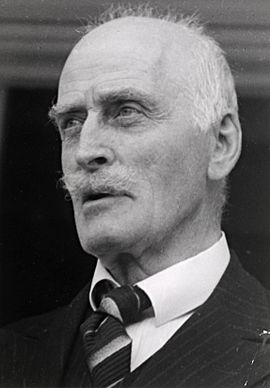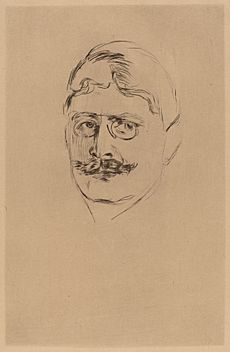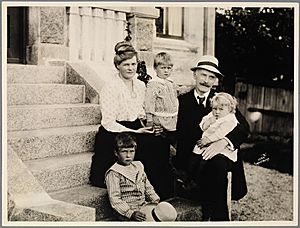Knut Hamsun facts for kids
Quick facts for kids
Knut Hamsun
|
|
|---|---|

Hamsun in 1939
|
|
| Born | Knud Pedersen 4 August 1859 Lom, Gudbrandsdalen, United Kingdoms of Sweden and Norway (present-day Lom, Norway) |
| Died | 19 February 1952 (aged 92) Nørholm, Grimstad, Norway |
| Occupation | Author, poet, dramatist, social critic |
| Period | 1877–1949 |
| Literary movement | Neo-romanticism Neo-realism |
| Notable awards | Nobel Prize in Literature 1920 |
| Spouses |
|
| Children | 5 |
| Signature | |
Knut Hamsun (born Knud Pedersen; August 4, 1859 – February 19, 1952) was a famous Norwegian writer. He won the Nobel Prize in Literature in 1920. Hamsun wrote for over 70 years, creating more than 20 novels. He also wrote poetry, short stories, plays, and travel books.
Hamsun is known as a very important and new writer from the late 1800s and early 1900s. He was one of the first to write about the inner thoughts of people. He used special writing styles like "stream of consciousness" and "interior monologue". Many famous writers, like Thomas Mann and Ernest Hemingway, were influenced by his work. Isaac Bashevis Singer even called Hamsun "the father of the modern school of literature." Many of Hamsun's books have been made into movies. In 2009, the Knut Hamsun Centre opened in Norway to celebrate his life and work.
When he was young, Hamsun did not like the usual writing styles of his time. He believed that modern books should explore the deep feelings and thoughts inside the human mind. He is seen as a leader of a new writing movement called "Neo-Romanticism." His early famous books include Hunger (1890), Mysteries (1892), Pan (1894), and Victoria (1898). Later, his books showed everyday life in rural Norway. They often used local ways of speaking, humor, and irony. Hamsun published only one book of poems, The Wild Choir.
During World War II, Hamsun openly supported Adolf Hitler and the Nazi ideas. Because of his support for the German occupation of Norway, he was charged with treason after the war. However, he was not found guilty because of his old age and health issues.
Contents
Life Story
Early Years
Knut Hamsun was born as Knud Pedersen in Lom, a valley in Norway. He was the fourth of seven children. When he was three, his family moved to Hamsund in Hamarøy. They were poor, and an uncle had asked them to farm his land.
At age nine, Knut went to live with his uncle, Hans Olsen. His uncle needed help with the post office he ran. Olsen treated Knut badly, often beating and starving him. Hamsun later said that his health problems came from how his uncle treated him.
In 1874, he ran away and went back to Lom. For the next five years, he took many different jobs to earn money. He worked as a store clerk, a traveling salesman, a shoemaker's helper, and a teacher.
When he was 17, he became a ropemaker's helper. Around this time, he also started to write. A rich businessman named Erasmus Zahl gave him money to help him. Hamsun later used Zahl as a model for a character named Mack in some of his novels.
Hamsun spent several years in America. He traveled and worked at different jobs. He later wrote a book about his experiences there.
Starting His Writing Career
All his different jobs helped him when he started writing. His first book was The Enigmatic Man: A Love Story from Northern Norway (1877). It was inspired by his own struggles and experiences.
His second novel, Bjørger (1878), tried to copy the style of another Norwegian writer, Bjørnstjerne Bjørnson. This story was about a poet named Bjørger and his love for a girl named Laura. Hamsun published this book using the name Knud Pedersen Hamsund. This book later became the basis for his famous novel Victoria: A Love Story (1898).
Important Books
Hamsun became widely known after his 1890 novel Hunger (Sult). This book was partly about his own life. It described a young writer who almost went crazy because of hunger and poverty in the Norwegian capital, Kristiania. Many people think this novel was an early example of the writing style used by authors like Franz Kafka. It showed a character's inner thoughts and strange logic.
Hamsun often wrote about a "wanderer." This was a traveling stranger, often the person telling the story, who would come into small country towns. This wanderer theme is important in novels like Mysteries, Pan, and Growth of the Soil.
Hamsun's writing often included beautiful descriptions of nature. He wrote about the Norwegian forests and coastline. He felt that people and nature were strongly connected. This connection is clear in books like Pan and Growth of the Soil. Growth of the Soil was a very important book that helped him win the Nobel Prize in Literature in 1920.
World War II and Its Aftermath
During World War II, Hamsun supported Germany's actions. He met with important Nazi leaders, including Adolf Hitler. After Hitler died, Hamsun wrote a short message saying Hitler was "a warrior for mankind."
After the war, Hamsun was held by the police on June 14, 1945. He was charged with treason because of his support for Germany. He was sent to a hospital because of his old age. In 1947, he was put on trial and had to pay a large fine. Norway's highest court later lowered the amount of the fine.
After the war, many Norwegians were upset by Hamsun's views during the war. They found it hard to separate their famous writer from his Nazi beliefs. At his trial, Hamsun said he did not fully understand what was happening. Some people think his support for Germany came from his dislike of democracy and his strong anti-British feelings.
His Death
Knut Hamsun died on February 19, 1952, when he was 92 years old. He passed away in Grimstad, Norway. His ashes are buried in the garden of his home.
His Impact
Thomas Mann said Hamsun was like a mix of Fyodor Dostoyevsky and Friedrich Nietzsche. Arthur Koestler liked his love stories. H. G. Wells praised Markens Grøde (1917), the book that won Hamsun the Nobel Prize in Literature. Isaac Bashevis Singer admired Hamsun's modern way of showing inner thoughts and using flashbacks.
In 1954, a 15-volume collection of Hamsun's complete works was published. In 2009, for his 150th birthday, a new 27-volume collection came out. This new edition included short stories, poems, plays, and articles that were not in the earlier collection. The language in these new books was updated to make them easier for today's Norwegian readers to understand.
Hamsun's books are still popular today. In 2009, a Norwegian writer said, "We can’t help loving him, though we have hated him all these years." This shows how complicated his legacy is in Norway.
Three of Hamsun's homes are now museums that people can visit. These include Hamsund gård, Hamsunstugu, and Nørholm. The Knut Hamsun Centre in Hamarøy is also open to the public.
The medal he received for the Nobel Prize is now missing.
Writing Style
Knut Hamsun was one of four famous Scandinavian writers known around the world. The others were August Strindberg, Henrik Ibsen, and Sigrid Undset. Hamsun was a pioneer in writing about the human mind. He used techniques like "stream of consciousness" and "interior monologue." These styles show a character's thoughts and feelings as they happen. Other writers like James Joyce and Virginia Woolf later used similar methods.
Family Life
In 1898, Hamsun married Bergljot Göpfert. They had a daughter named Victoria, but their marriage ended in 1906. Hamsun then married Marie Andersen in 1909. She stayed with him for the rest of his life. They had four children together: sons Tore and Arild, and daughters Ellinor and Cecilia.
Marie wrote two books about her life with Hamsun. She was a promising actress when they met, but she stopped her career to be with him. They bought a farm, hoping to make a living as farmers.
After a few years, they moved south. In 1918, they bought Nørholm, an old manor house. They fixed up the main house. Here, Hamsun could write without being disturbed. However, he often traveled to other cities to write, preferring simple places.
Books Made into Movies and TV Shows
Many of Hamsun's books have been made into films and TV shows. One of the most famous is Hunger, a 1966 movie starring Per Oscarsson. It is still thought to be one of the best film versions of Hamsun's work. Overall, 25 films and TV mini-series have been based on his writings, starting in 1916.
His book Mysteries was made into a 1978 film with the same name.
Landstrykere (Wayfarers) is a Norwegian film from 1990.
The Telegraphist is a Norwegian movie from 1993. It is based on Hamsun's novel Dreamers.
His novel Pan has been made into four films between 1922 and 1995. The most recent one was a Danish film in 1995.
Movie About His Life
A movie about Hamsun's life, called Hamsun, came out in 1996. It was directed by Jan Troell, and Max von Sydow played Knut Hamsun.
See also
 In Spanish: Knut Hamsun para niños
In Spanish: Knut Hamsun para niños




